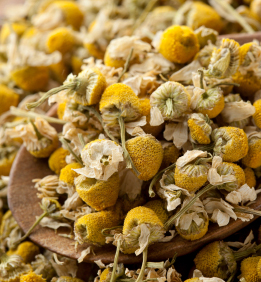Matricaria chamomilla, Chamomile
- Belongs to the Asteraceae/Compositae family
- Chamomile is a plant native to the old world – Western Asia and Europe – although it now grows in much of the world including the U.S. as a wildflower.
- Chamomile is an ancient herb that has been used for thousands of years by humans for a variety of personal and health purposes.
- Application/Consumption: Dry powder for topical application. Dried and steeped as tea. scented oil for perfume and cosmetics.
- It is an annual plant that can be characterized by small golden yellow tubular florets.

Traditional Uses of Chamomile
For millennia chamomile has been used as an herbal supplement. Some of its most popular uses include being a mild sedative to promote sleep, help with nightmares, calm nerves and solve other sleep related problems.For this purpose, chamomile is typically consumed in an aqueous fashion, as tea. Chamomile tea is made from the dried flowers of the plant which contain valuable flavenoids and terpenoids which contribute to the medicinal qualities of the herb.

Fun Fact: an estimated +1,000,000 cups of chamomile tea are drank every day!
The Herb has also been known to treat a variety of skin conditions including inflammation and bacterial infection.
The uses of chamomile are very extensive, aside of skin and sleep related disorders chamomile has been used to treat fevers, GI disorders, joint and back pain, stomach cramps, nasal inflammation, and many other symptoms.
Outside of medicinal purposes, the chamomile flower is also a popular perfume scent and may be useful in aromatherapy.
Secondary Metabolites
The active ingredients if many medicinal plants and herbs fall into the class of secondary metabolites. When the bioactive ingredients of the chamomile flower are concentrated you obtain mixture of volatile oils that are yellow in color. This oil is a composite of roughly 120 different secondary metabolites, many of which are flavenoids and terpenoids such as α-bisabolol. These flavenoids contained in the extract possess anti-inflammatory properties. This broad array of secondary metabolites are responsible for giving the flower its many medicinal qualities.
Scientific Research
Because of the broad number of uses and value of the Chamomile flower through history, it is one of the most researched and understood medicinal plants in the world today. Scientists and health professionals agree on its relative safety and support its use. Although, like any herbal supplement or medication, its effects are variable from person to person and it should not be relied on to make major contributions to your health.
Anti-Cancer Study
Apigenin, an active constituent of chamomile, has shown limited yet promise effects as a growth inhibitor. Studies show that while normal cells are unaffected or minimally inhibited by treatment of chamomile extract cancerous cells show reduced growth. Similarly, Exposure to a certain concentration of the extract may induce apoptosis in tumors but not in healthy cells. On top of a high safety rating ,a mixture of botanical elements including chamomile extract could be a promising anti-cancer drug alternative.
Generalized Anxiety Disorder (GAD)
Studies are being done on the treatment of GAD with German Chamomile but so far evidence appears contradictory and thus inconclusive.
Diabetes
Chamomile may reduce the effects of diabetes via protective effects on pancreatic beta cells as well as increased glycogen storage in the liver and suppression of blood glucose levels. Further studies are required to draw conclusions.
Sources:
https://www.ncbi.nlm.nih.gov/pmc/articles/PMC2995283/
https://www.ncbi.nlm.nih.gov/pmc/articles/PMC3210003/
http://www.injoynow.com/flower-sprays/38-chamomile-flower-essence-12-oz-bottle-with-dropper.html
http://www.save-on-crafts.com/chamomile1.html
Page created by Taylor Lesmeister